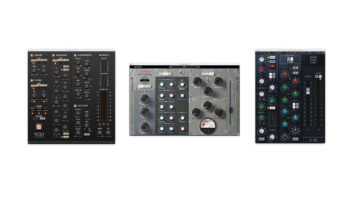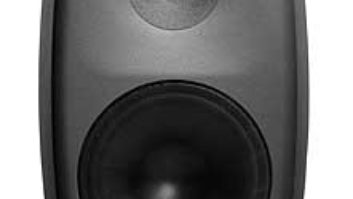UNDERSTANDING AC/DC, SERIES/PARALLEL, RESISTANCE ANDIMPEDANCE
We interface equipment every day, assuming and hoping that therelationship between source and destination will be a happy one. Inany electrical circuit, impedance is a major part of thatrelationship, a rather deep subject that had me pouring through oldtextbooks and wishing I could still do the math. Here is my“Piece de Resistance,” an overview of basic electronicinformation that will prepare you for next month’s furtheradventures.
AC/DC: THE JUICE
Electricity can be described as an Electromotive Force (EMF).You know AC — alternating current — as sound and power(the giant hum that comes from wall outlets). Batteries deliverdirect current (DC). Both are expressed in volts. AC can betransformed, rectified and filtered into DC — power suppliesdo this most of the time.
AC implies time by way of repetition. The frequency of AC isstated in Hertz — Hz — formerly known as “CyclesPer Second,” or CPS. It is easiest to imagine one completecycle of a sine wave starting at zero volts — going positive,then crossing zero, going negative and returning to zero. Beforevacuum tubes, transistors or IC op amps can amplify AC, they mustfirst be “turned on,” biased with DC usingresistors!
STORAGE
AC cannot be contained like DC, which can be“stored” in an electrochemical form as a battery or inan electrostatic form as a capacitor. Imagine filling a bathtubwith water or parking a car at the top of a very steep hill. Withgravity as “the force,” throwing the switch isequivalent to pulling the drain plug or releasing the brake.
Unlike the popular water analogy, DC does not leak from thebattery terminals, although, sometimes, the chemicals do. When ACand DC are put to work, however, magnetic energy is radiated intothe air from the cabling, the principle behind inductors andtransformers. Radiated AC, in the form of hum and buzz, finds itsway into vulnerable “appliances” such as electricguitar and bass — another topic!
DC might imply a constant polarity and voltage, but time cannotbe frozen. Even a battery — disposable or rechargeable— holds a charge over a defined period of time that isprimarily determined by use. Within time as we know it, arechargeable battery has a charge and recharge “cycle,”still technically DC, yet one could argue it being of subsonicfrequency.
SERIES AND PARALLEL
Two circuit configurations are shown in Fig. 1a and Fig. 1busing resistors for each example, along with the respectiveformulae for calculating total resistance. Figure 1a showsresistors in series configuration, and Fig. 1b demonstratesparallel. In series, resistor values are simply added together. Thetotal resistance decreases in the parallel configuration; theformula as shown matches the example but can be continued adinfinitum. Add more resistors, and the end result will eventuallyapproach zero ohms; in essence, a piece of wire.
Note: Both “E” and “V” may be used todenote voltage.
Test No. 1: It is common knowledge that two 8-ohm speakersconnected in parallel becomes 4 ohms. What if the two speakers were8 ohms and 4 ohms? (Answer No. 1: 2.6 ohms.)
Tip: Most Windows PCs have a calculator with both Standard andScientific modes.
Test No. 2a: Ohm’s Law and the power formula are included inFig. 1. These essential electronic tools are used to determinecurrent flow and power consumption. Most cars have a 12-voltbattery. Assuming that the sound system’s amplifier can swing 10volts peak-to-peak, what is the peak power output of one channelinto an 8-ohm load? (Answer No. 2a: 12.5-watts peak power.)
Test No. 2b: (Bonus Question) What is the RMS power for the samesound system? Hint: See the February issue of this column. (AnswerNo. 2b: 1.56-watts RMS.)
LYNN EAR
Like the water analogy, a variable resistor can be viewed as avalve, although vacuum tubes and transistors are much moreefficient when “heavy lifting” is required. In arecording console, for example, the effect and aux sends areexamples of variable resistors in the form of rotary potentiometers(pots).
Most pots are three-terminal devices. Typical connections to alinear fader are detailed in Fig. 2. The input is at the top,output via the middle terminal (called the “wiper”) andthe bottom terminal is the signal common, typically connected toground. The wiper divides the resistor into two parts: The ratio ofthe bottom resistor to the total resistance determines the amountof input signal that is output. The very first example in the tableon p.116 is the easiest to visualize.
The table defines 16-bits of dynamic range in 6dB increments asrepresented by the change in voltage and the equivalent resistancefor a 10-kilohm fader.
A mechanically linear fader may also be electronically linearwhen a DC control voltage is used for VCA-type automation. Thetable on p. 116 shows how an audio taper pot differs. Starting with10 volts at the top of a 10-kilohm fader, each 6dB drop representsa 50% voltage reduction from the previous value. While the firstdrop from 10 volts to 5 volts is half the electrical value, youknow that the wiper knob will not be halfway down.
Test No. 3: Imagine a fader that is both mechanically andelectrically linear. Put in 10 volts at the top, set it halfway andget 5 volts out. The fader comes in three resistance options— 1,200 ohms, 4,800 ohms and 10 kilohms. The equivalentcircuit is a series resistor pair consisting of…(Answer No.3: 600, 2,400 and 5 kilohms, respectively.)
Test No. 4: The resistive element in an audio taper pot is“logarithmic,” matching the ear’s nonlinear sensitivityto level changes. It’s hard to avoid the math, but I encouragethose with access to a scientific calculator to engage the dBformula at the lower right corner of Fig. 2. Divide any twovoltages from the table, take the log and multiply by 20. Compareyour answers with those in the table. It feels good, doesn’t it? Iused to do this on a slide rule!
MIX MASTER
In a mixer, an IC op amp may have to feed several effect sendsas well as the primary fader. If four pots will be connected to anop amp, then it is important, for the sake of efficiency, to choosean optimal resistance value that, when combined in parallel, isn’tso low as to overload the op amp or so high as to be vulnerable tostray capacitance (next month’s topic).
For ease of head calculation, I chose four 2,400-ohm resistors.Combine the first two pairs into a single pair of 1,200-ohmresistors and then combine those into one 600-ohm load. This, too,is a magic number, vintage gear having input and output impedancesof 600 ohms and being referenced to 0 dBm. The Power formula (inFig. 1a) states that P equals E-squared divided by R. In this case,E is 0.775 volts.
Test No. 5: Apply .775 volts to the load and determine thepower. (Answer No. 5: 1 milliwatt.)
Note: One mW is the reference for 0 dBm, 4 dB below“nominal” level for professional equipment.
Many op amps can comfortably drive a 600-ohm load. But within amixer module, only the output amps need to be prepared to work thishard and only when driving vintage-style equipment. Typical potvalues are between 5k and 10 kilohms. Four 10-kilohm pots representa 2,500-ohm load to the op amp.
Test No. 6: Can you calculate the power if 0.775 volts appearacross a 2,500-ohm load? (Answer No. 6: 0.24 milliwatts.)
THE SCIENTIFIC METHOD
In all of the sciences, it is common to minimize the variablesto facilitate understanding and simplify calculation, if only forthe moment. With that in mind, consider impedance as the full-colorversion of resistance. The series parallel circuit examples in thisarticle consisted mostly of a battery and resistors —certainly not the real world, so black and white that there wasn’teven a power switch! AC voltages were treated like DC, except whencalculating peak and RMS power.
Oversimplified, impedance is to AC as resistance is to DC. Whileboth quantities are expressed in “ohms,” the formerrequires higher math (trigonometry and calculus); the latter canpretty much be ciphered in your head. With the exception of the“dB” formula, the math presented in this article isquite basic. You calculated current using Ohm’s Law — 10volts divided by 10 ohms is 1 ampere — but if a capacitor orinductor were in the circuit, the voltage and current would changeover time, requiring several calculations. Even the switch wouldplay a key role!
Next month’s math takes time into consideration, but don’t getnervous about it. A demo version of “Micro-Cap 6” isavailable at www.spectrumsoft.com as a free download. Just draw aschematic and it does the ciphering. Meanwhile, let’s lookat the basic concepts comparing resistance to impedance.
SPECIFIC HEIGHTS
Resistance is a scalar quantity measured in ohms, just as theterm “height” is defined by its magnitude (inches,feet, centimeters, meters) and no more. By contrast, temperature isdefined by its magnitude — degrees — which alone doesnot tell the whole story. Wind can make a 20° day feel like10° (wind chill), while humidity can make 70° feel like80° (the yuck factor). Like the temperature example, impedanceis a vector quantity defined by its magnitude in ohms, but insteadof wind chill, there is a phase angle, a manipulation of time.
I-C-E IS N-I-C-E
Remember that DC can be stored over long periods of time inbatteries and to a lesser extent in capacitors. Add a switch to theseries or parallel resistor examples. At the moment, the voltage Eis applied to the resistance R no matter whether the source is ACor DC, the current will be instantaneous.
Reactive components — capacitors and inductors —manipulate the time relationship between voltage and current. Afully discharged capacitor appears as a dead short at the moment itis connected to a DC voltage source, the current leading thevoltage by 90°. In engineering school, simple expressions suchas “E-L-I the I-C-E man” helped students remember thatvoltage-leads-current by 90° in an inductor L (a coil ofwire).
SPARK!
Have you ever plugged or unplugged a device when its switch wasin the On position? At the exact moment the plug and socket made orbroke the connection, a sizeable spark most likely occurred.Connecting AC power to a reactive device such as a transformer isone of the reasons lights dim but don’t stay dim when a device isturned on.
ABSOLUTE ZERO
Getting back to the temperature analogy for a moment, thematerials used for making or plating wire — copper, silver,gold or aluminum — all have a defined resistance at roomtemperature. Absolute zero on the Kelvin scale (0 K) is the lowesttemperature theoretically possible — at approximately-273.16° C (-459.69° F). Wire that cold becomes a moreperfect conductor. That’s why audiophiles love winter here inMinnesota!
In reality, the slight amount of resistance per foot becomescumulative with extremes of distance or of thinness. For example,speaker cable consists of a pair of conductors separated byinsulation, a capacitor by definition that becomes a contributingfactor as the series resistance increases. At high frequencies, thewire also has some inductance. Hold that thought…
Next month, the circuit examples will include capacitors andinductors in real-world examples of signal corruption and failingcomponents. In the meantime, drop by www.tangible-technology.com for a visit.
This past winter, Eddie shoveled 65 inches of snow. By thetime you read this, he’ll be planting a vegetable garden. Got anyseeds?







